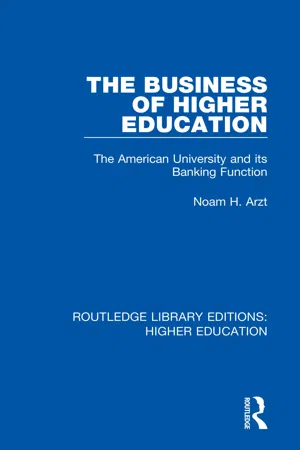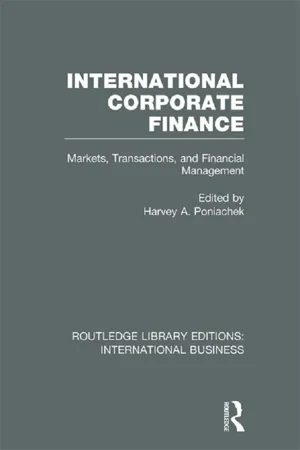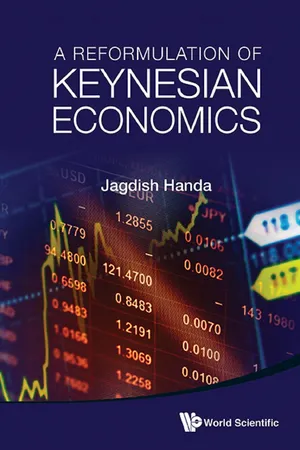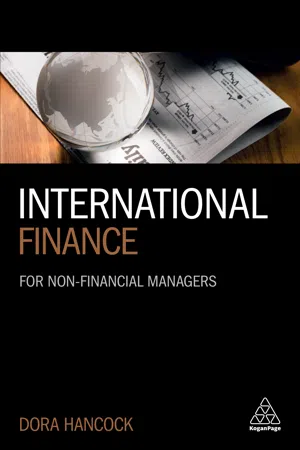Economics
Financial Institutions
Financial institutions are organizations that provide financial services to individuals and businesses. They include banks, credit unions, insurance companies, investment firms, and other entities that facilitate the flow of funds in the economy. These institutions play a crucial role in allocating capital, managing risk, and providing liquidity to support economic activities.
Written by Perlego with AI-assistance
Related key terms
4 Key excerpts on "Financial Institutions"
- eBook - ePub
The Business of Higher Education
The American University and its Banking Function
- Noam Arzt(Author)
- 2018(Publication Date)
- Routledge(Publisher)
Implicit in all of these intermediation services is the sharing of risk by the bank with other parties. The bank, of course, charges a fee for assuming part of the risk. Normally, this fee is represented by the difference between the interest charged to the borrowers and the interest paid to the providers of capital. The provision of transaction services also involves risk to the bank. Particularly with respect to check processing, and to a lesser degree with electronic fund transfers, there is always the risk that funds that need to flow into the bank will not be available when demanded. Different banks develop different policies and procedures to minimize this risk, usually by restricting to the customer the availability of funds to be collected from other banks until the funds are actually retrieved. Recent regulation has begun to limit the amount of time banks may withhold a depositor’s access to newly-deposited funds.Financial Services Institutions
Creating an exact definition of a bank is difficult. The Bank Holding Company Act defines and uses “bank” to mean “commercial bank.”2 Anything else is a “non-bank bank”. A more functional definition is preferred, which looks at the services performed and the customers served in the context of the functions described above. Figure 4.1 displays the types of financial services institutions in the United States. The left side of the figure deals with banking institutions; the right side deals with non-bank banks. In this framework, institution types that clearly provide both transaction and intermediation services together to some broad constituency are defined as banks. The transaction services must include a demand deposit account, or a close functional equivalent (e.g. NOW accounts). Any institution types that offer either transaction or intermediation services, but not both (typically the latter), are classified as non-bank banks. The status of the Academic Bank has yet to be determined.While non-bank banks perform financial services functions they are outside of the regulatory constraints of the banking industry. They are also more focused in the services they perform. Before the Academic Bank can be fully understood, the similarities and differences between these different kinds of banks and non-bank banks must be explained. - eBook - ePub
International Corporate Finance (RLE International Business)
Markets, Transactions and Financial Management
- Harvey Poniachek(Author)
- 2013(Publication Date)
- Routledge(Publisher)
5 Financial Institutions in International Finance Alexander E. FlemingDOI: 10.4324/9780203076590-7CHANGES in the international economic and financial environment during the 1970s and 1980s have brought with them marked changes in the ways in which international financial intermediation is conducted. There have been significant shifts in the roles played by private Financial Institutions (especially commercial banks and investment banks) on the one hand and official Financial Institutions (especially the IMF and World Bank) on the other. There have also been important shifts in the roles played by institutions within each category. This chapter examines some of the factors that have influenced the nature and scale of participation of the different types of institution in international finance.International Financial Intermediation: An Overview
The international financial system—encompassing institutional, governmental, and market arrangements for transactions between countries—performs on a global basis what national financial systems execute domestically. It provides a payments mechanism, offers facilities for borrowing funds and employing surpluses, creates different types of financial assets and liabilities, and intermediates between a variety of agents with portfolio preferences.The demarcation between national and international financial systems has never been rigid because domestic institutions and markets have always to some extent performed international functions. Until the late 1960s, however, a reasonably coherent distinction could be made between the two systems. International financial intermediation and the financing of international payments imbalances were based mainly on governmental arrangements and official international organizations. Balance-of-payments financing was not, therefore, done predominantly through market mechanisms but rather through nonmarket operations. Except for trade financing, most domestic Financial Institutions operated primarily in the domestic domain. But since the late 1960s the international and national financial systems have become more closely integrated. The formal distinctions between the intermediation mechanisms used by the two have become less obvious as national Financial Institutions have increasingly come to supply international financial intermediation services. - eBook - ePub
- Jagdish Handa(Author)
- 2015(Publication Date)
- WSPC(Publisher)
One of the providers of financial capital to the economy is commercial banks. Besides being holders of the public’s deposits, banks provide loans to the public, so that they are also providers of financial capital, especially credit. Our concern in this chapter is mainly with financial capital and the latter role of the banks, rather than with the banks’ role as takers of deposits and creators of money. On the latter, the literature provides extensive treatment of the determination of the money supply and its dependence on the monetary base (see Handa, 2009, Chapter 10), so that this chapter examines only the creation of financial capital by banks.The activities of banks have evolved considerably in recent decades. A glimpse into this evolution is provided by caricaturing banks as either “traditional” (sometimes referred to as “retail”) or as “modern (or non-traditional).” Of these, the former is defined as a financial intermediary (FI) that, besides its own capital (raised through equities and retained earnings), takes in deposits from the public and makes loans (to the private sector) or purchases short-term marketable securities (in some case, only government ones), but does not itself issue its own securities, nor does it engage in securitization (i.e., sale of the loans made by it or “bundling mortgages” and selling them). The modern bank is defined as one that takes in deposits and also engages in one or more of these activities. That is, it takes in deposits, issues its own securities and resells its loans, so that it goes beyond the activities performed by the traditional bank by also raising funds through issues of its own securities and re-sales of the loans made by it. Table 6.1 - eBook - ePub
International Finance
For Non-Financial Managers
- Dora Hancock(Author)
- 2018(Publication Date)
- Kogan Page(Publisher)
02The institutions and participants that make up the global financial system
At the end of this chapter you will be able to:- identify and discuss the participants in the global financial system, particularly the role of central banks;
- discuss the need for banking regulation and supervision and the difficulties faced by legislators;
- briefly describe what happened in the global financial crisis.
Introduction
The Financial Times defines the global financial system as:This is the interplay of financial companies, regulators and institutions operating on a supranational level. The global financial system can be divided into regulated entities (international banks and insurance companies), regulators, supervisors and institutions like the European Central Bank or the International Monetary Fund. The system also includes the lightly regulated or non-regulated bodies – this is known as the ‘shadow banking’ system. Mainly, this covers hedge funds, private equity and bank-sponsored entities such as off-balance-sheet vehicles that banks use to invest in the financial markets.The global financial system has grown over recent decades to meet the needs initially of international trade, and today to meet the complex needs of companies, investors, governments, banks and everyone seeking to borrow or invest money or to use a currency other than their domestic currency.One way or another almost all of us have some contact with the global financial system. Holidaymakers will be affected by changes in exchange rates, finding their holiday more or less expensive than in previous years. Oil and fuel are priced in dollars so the fall in the value of sterling following the Brexit vote led to an increase in fuel prices across the UK. In practice, there are also links between the interest rates that different countries charge and this impacts on the cost of borrowing for most of us.
Index pages curate the most relevant extracts from our library of academic textbooks. They’ve been created using an in-house natural language model (NLM), each adding context and meaning to key research topics.



